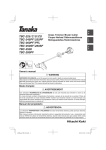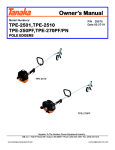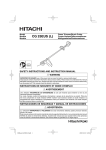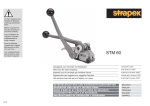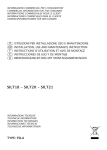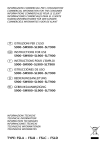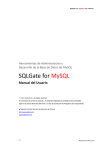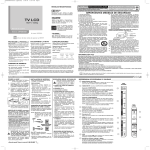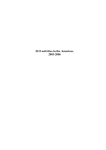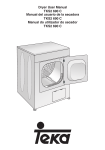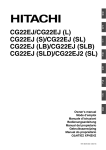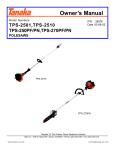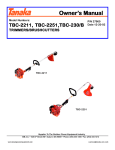Download 4"# 4"# $8 4"#
Transcript
4"# 4"#$8 4"# /WNERSMANUAL -ANUALDELPROPIETARIO 970-47189-200 2009.05 TBC-550/TBC-600 4"# 4"#$8 4"# Read the manual carefully before operating this machine. Owner's manual GB-1 TBC-550/TBC-600 Meanings of symbols or labels. (NOTE! Some units do not carry them) WARNING The engine exhaust from this product contains chemicals known to the State of California to cause cancer, birth defects and other reproductive harm. Do not use metal/rigid blades when this sign is shown on the unit. Read, understand and follow all warnings and instructions in this manual and on the unit. 15m 50FT 15m 50FT Keep all children, bystanders and helpers 15m away from the unit. If anyone approaches you, stop the engine and cutting attachment imme-diately. It is important that you read, fully understand and observe the following safety precautions and warnings. Careless or improper use of the unit may cause serious or fatal injury. Be careful of thrown objects. Always wear eye, head and ear protectors when using this unit. GB-2 TBC-550/TBC-600 Max 9,900rpm Blade thrust may occur when the spinning blade contacts a solid object in the critical area. A dangerous reaction may occur causing the entire unit and operator to be thrust violently. This reaction is called BLADE THRUST. As a result, the operator may lose control of the unit which may cause serious or fatal injury. Blade thrust is more likely to occur in areas where it is difficult to see the material to be cut. Shows maximum shaft speed. Do not use the cutting attachment whose max rpm is below the shaft rpm. Gloves should be worn when necessary, e. g., when assembling cutting equipment. Explains choke position. Upper sign indicates choke closed and the lower fully open. Use anti-slip and sturdy footwear. P L A CE GUA RD B RA CK ET B E TW E E N A RROW S Indicates blade guard location for a trimmer head or Brain head. Do not attach handle above this point Indicates handle location. Do not attach handle above this point. WARNING! Read the Operator's Manual and follow all warnings and safety instructions. Failure to do so can result in serious injury to the operator and /or bystanders. Objects may be thrown or ricochet in all directions. ALWAYS WEAR EYE PROTECTION. Keep bystanders at least 50 feet (15m) away. To reduce the chance of hearing loss, always wear ear protection. To reduce the risk of injury from loss of control, never use a metal blade on a curved shaft grass trimmer. Never use a metal blade on any brushcutter without barrier bar or bicycle handle configuration and safety strap Use of a blade may cause a sudden sideways, forward or backward motion of the brushcutter when the blade contacts a solid object. See Owner's manual for model specific details. Before using your machine Read the manual carefully. Check that the cutting equipment is correctly assembled and adjusted. Start the unit and check the carburetor adjustment. See "Maintenance". GB-3 TBC-550/TBC-600 Index What is what? Warnings and safety instructions Assembly procedures Operating procedures Maintenance Specifications GB-4 5 6 7 9 12 14 TBC-550/TBC-600 1. What is what? Since this manual covers several models, there may be some difference between pictures and your unit. Use the instructions that apply to your unit. 1. Fuel cap 2. Throttle trigger 3. Starter handle 4. Blade guard 5. Cutting attachment 6. Drive shaft tube 7. Handle bar 8. Suspension eyelet 9. Ignition switch 10. Harness 11. Throttle lock 12. Throttle trigger lookout 13. Choke lever 14. Engine 15. Angle transmission 9 15 5 11 6 2 12 4 14 8 7 13 3 1 10 TBC-500 / 550 10 TBC-550DX 9 5 15 11 2 12 7 14 10 8 4 6 13 3 1 TBC-600 GB-5 TBC-550/TBC-600 2. Warnings and safety instructions Operator safety Always wear a safety face shield or goggles. Always wear heavy, long pants, boots and gloves. Do not wear loose clothing, jewelry, short pants, sandals or go barefoot. Secure hair so it is above shoulder length. Do not operate this tool when you are tired, ill or under the influence of alcohol, drugs or medication. Never let a child or inexperienced person operate the machine. Wear hearing protection. Never start or run the engine inside a closed room or building. Breathing exhaust fumes can kill. Keep handles free of oil and fuel. Keep hands away from cutting equipment. Do not grab or hold the unit by the cutting equipment. When the unit is turned off, make sure the cutting attachment has stopped before the unit is set down. When operation is prolonged, take a break from time to time so that you may avoid possible whitefinger disease which is caused by vibration. Unit / machine safety Inspect the entire unit/machine before each use. Replace damaged parts. Check for fuel leaks and make sure all fasteners are in place and securely tightened. Replace parts that are cracked, chipped or damaged in any way before using the unit/machine. Make sure the safety guard is properly attached. Keep others away when making carburetor adjustments. Use only accessories as recommended for this unit/machine by the manufacturer. WARNING! Never modify the unit/machine in any way. Do not use your unit/machine for any job except that for which it is intended. Fuel safety Mix and pour fuel outdoors and where there are no sparks or flames. Use a container approved for fuel. Do not smoke or allow smoking near fuel or the unit/machine or while using the unit/machine. Wipe up all fuel spills before starting engine. GB-6 Move at least 3 m away from fueling site before starting engine. Stop engine before removing fuel cap. Empty the fuel tank before storing the unit/machine. It is recommended that the fuel be emptied after each use. If fuel is left in the tank, store so fuel will not leak. Store unit/machine and fuel in area where fuel vapors cannot reach sparks or open flames from water heaters, electric motors or switches, furnaces. etc. Transport and storage Carry the unit/machine by hand with the engine stopped and the muffler away from your body. Allow the engine to cool, empty the fuel tank, and secure the unit/machine before storing or transporting in a vehicle. Empty the fuel tank before storing the unit/machine, It is recommended that the fuel be emptied after each use. If fuel is left in the tank, store so fuel will not leak. Store unit/machine out of the reach of children. Clean and maintenance the unit carefully and store it in a dry place Make sure engine switch is off when transporting or storing. When transporting in a vehicle, cover blade with blade cover. WARNING! Antivibration systems do not guarantee that you will not sustain whitefinger disease or carpal tunnel syndrome. Therefore, continual and regular users should monitor closely the condition of their hands and fingers. If any of the above symptoms appear, seek medical If situations occur which are not covered advice immediately. in this manual, take care and use common sense. Contact Tanaka dealer if you need Cutting safety assistance. Pay special attention to Do not cut any material other than grass statements preceded by the following and brush. words: Inspect the area to be cut before each use. Remove objects which can be thrown or become entangled. For respiratory protection, wear an aerosol protection mask when cutting the grass after insecticide is scattered. Keep others including children, animals, bystanders and helpers outside the 15 m hazard zone. Stop the engine immediately if you are approached. Always keep the engine on the right side of your body. Hold the unit/machine firmly with both hands. Keep firm footing and balance. Do not over-reach. Keep all parts of your body away from the muffler and cutting attachment when the engine is running. Keep cutting attachment below waist level. Maintenance safety Maintain the unit/machine according to recommended procedures. Disconnect the spark plug before performing maintenance except for carburetor adjustments. Keep others away when making carburetor adjustments. Use only genuine Tanaka replacement parts as recommended by the manufacturer. WARNING! Indicates a strong possibility of severe personal injury or loss of life, if instructions are not followed. CAUTION! Indicates a possibility of personal injury or equipment damage, if instructions are not followed. NOTE! Helpful information for correct function and use. TBC-550/TBC-600 2 1 1 3 Fig. 1-1 Fig. 1-1B Fig. 1-2B Fig. 1-2C Fig. 1-2 Fig. 1-2D 1 3 2 Fig. 1-2E Fig. 1-3 3. Assembly procedures Drive shaft to engine (Fig. 1-1) Loosen tube locking bolt (1). Insert the drive shaft into the clutch case of the engine properly until the marked position (2) on the drive shaft tube meets the clutch case. NOTE! When it is hard to insert drive shaft up to the marked position on the drive shaft tube, turn drive shaft by the cutter mounting end clockwise or counter-clockwise. Tighten tube locking bolt lining up the hole in the shaft tube. Then tighten clamp bolt securely (3). Drive shaft to engine for TBC-550DX (Fig.1-1B) Attach the engine to the clutch case (2) with the four screws or bolts (1) provided. Installation of handle (Fig. 1-2) Remove the handle bracket (1) from the assembly. (Fig. 1-2) Place the handles and attach the handle bracket with four bolts lightly. Adjust to appropriate position. Then fix it firmly with the bolts. Installation handle for TBC-550DX (Fig. 1-2D, 1-2E) Place the handles and attach the handle bracket with the handle knob lightly. Adjust appropriate position. Then fix it firmly with the handle knob. Throttle wire/stop cord Put stop cords(3) and throttle wire(1) through protection tube(2). Then unhook the hip pad and wrap the protected stop cords and throttle wire (1) with it (Fig.1-3) NOTE Fix protection tube on drive shaft(TBC-550) or handle(TBC-550DX) using cord clamps. Attach throttle grip on the handle with a screw and nut. NOTE for TBC-600 (Fig. 1-2B, 2C) The drive shaft and the engine of this model are pre-assembled at the factory. All you have to do is attach throttle grip on the handle with a screw and a nut and then, install it on the handle brackets. Finger-tighten the knob nut securely. GB-7 TBC-550/TBC-600 SW. Fig. 1-8 TBC-550DX Fig. 1-8B Fig. 1-8D Fig. 1-9 Fig. 1-8E Installation of blade guard (Fig. 1-8, 8B, 8D, 8E) NOTE! The guard bracket may come already mounted to the gear case on some models. Install the blade guard on drive shaft tube against angle transmission. Tighten the guard bracket firmly so that the blade guard does not swing or move down during operation. (TBC-550DX) 1. Install the blade guard (2) on the shaft with the guard bracket (3), the cover holder (1) and the screw provided. (Fig. 1-8D) NOTE ! (Fig. 1-8D) The part (4) on the blade guard should be against the gear case. 2. Tighten the screws after setting the guard bracket the appropriate position. GB-8 Fig. 1-9C CAUTION! Some blade guards are equipped with sharp line limiters. Be careful with handling it. NOTE! (Fig. 1-8E) When using a Tanaka aluminum head (CH-100 or CH-300) on your unit, the sharp line limiter (2) which is included in the tool bag, should be securely fastened to the blade guard using the bolt shown (3). When using a trimmer head with two piece type blade guard, attach the guard extension to the blade guard. (Fig. 1-9) NOTE! If your unit has guard location label on drive shaft tube, follow the indication. NOTE! When attaching the guard extension to the blade guard, the sharp line limiter must be removed from the blade guard, (if so installed). NOTE! To remove the guard extension, refer to the drawings. Wear gloves as the extension has a sharp line limiter, then push the four square tabs on the guard one by one in order. (Fig. 1-9C) TBC-550/TBC-600 2 2 3 3 1 1 4 5 4 Fig. 1-10 Fig. 1-10B 5 1 B 25-50 17cm 17cm A CH-100 Fig. 1-10C Installation of cutting blade (Fig.1-10,10B) (If so equipped) When installing a cutting blade, make sure that there are no cracks or any damage in it and that the cutting edges are facing the correct direction. NOTE! When installing cutter holder cap (1), be sure to set concave side upward. Insert the allen wrench (2) into the hole of the angle transmission in order to lock the cutter holder (3). Please note that the cutter fixing bolt or nut (4) has left-handed threads, (clockwise to loosen/counter-clockwise to tighten). Tighten the fixing bolt or nut with the box wrench. NOTE! If your unit is of a nut securing type and equipped with a cotter pin, the blade must be retained with a new cotter pin (5) each time installed. (Fig. 1-10C) CAUTION! Before operation, make sure the blade has been properly installed. CAUTION! If your unit is equipped with protection cover under a cutting blade, check it for wear or cracks before operation. If any damage or wear is found, replace it, as it is an article of consumption. Installation of the BRAIN cutting head NOTE! For installation see your BRAIN Owner's manual, provided with the BRAIN cutting head. Fig.2-1 Fig. 1-11 WARNING! For TANAKA BRAIN heads or TANAKA alloy head, use only flexible, non-metallic line recommended by the manufacturer. Never use wire or wire ropes. They can break off and become a dangerous projectile. Always start by filling half the amount of fuel, which is to be used. Then add the whole amount of oil. Mix (shake) the fuel mixture. Add the remaining amount of fuel. Mix (shake) the fuel-mix thoroughly before filling the fuel tank. NOTE! When using TANAKA alloy head (CH-100), initial cutting line length should be about 17cm each. (Fig. 1-11) Fueling 4. Operating procedures. Fuel (Fig. 2-1) WARNING! The trimmer is equipped with a two-stroke engine. Always run the engine on fuel, which is mixed with oil. Provide good ventilation, when fueling or handling fuel. WARNING! Always shut off the engine before refueling. Slowly open the fuel tank, when filling up with fuel, so that possible over-pressure disappears. Tighten the fuel cap carefully, after fueling. Always move the trimmer at least 3 m (10 ft.) from the fueling area before starting. Before fueling, clean the tank cap area carefully, to ensure that no dirt falls into the tank. Make sure that the fuel is well mixed by shaking the container, before fueling. Fuel Always use branded 89 octane unleaded gasoline. Use genuine two-cycle oil or use a mix between 25:1 to 50:1, please consult the oil bottle for the ratio or Tanaka dealer. Only for the state of California at 50:1. If genuine oil is not available, use an anti-oxidant added quality oil expressly labeled for air-cooled 2-cycle engine use(JASO FC GRADE OIL or ISO EGC GRADE). Do not use BIA or TCW (2-stroke water-cooling type) mixed oil. Never use multi-grade oil (10 W/30) or waste oil. Always mix fuel and oil in a separate clean container. GB-9 TBC-550/TBC-600 2 2 4 1 1 HL 3 3 5 Fig.2-2 Starting (Fig. 2-2, 2B) CAUTION! Before starting, make sure the cutting attachment does not touch anything. 1. Set ignition switch (1) to ON position. (Fig. 2-2, 2B) *Push priming bulb (5) several times so that fuel flows through return pipe (If so equipped)(Fig. 2-3) 2. With the safety trigger (2) pressed (if so equipped), pull throttle trigger and push throttle lock (3), then slowly release the throttle trigger first, then the safety trigger. This will lock the throttle in starting position. (Fig. 2-2, 2B) 3. Set choke lever to CLOSED position (4). (Fig. 2-3) 4. Pull recoil starter briskly, taking care to keep the handle in your grasp and not allowing it to snap back. 5. When you hear the engine want to start, return choke lever to RUN position (open). Then pull recoil starter briskly again. NOTE! If engine does not start, repeat procedures from 2 to 5. 6. After starting engine, pull throttle trigger to release throttle lock. Then allow the engine about 2-3 minutes to warm up before subjecting it to any load. GB-10 Fig.2-2B Fig.2-3 TBC-550/TBC-600 Fig. 2-4 Fig. 2-4B Fig. 2-4C 15m Fig. 2-4D Cutting (Fig. 2-4, 4B, 4C, 4D) When cutting, operate engine at over 6500 rpm. Extended time of use at low rpm may wear out the clutch prematurely. Cut grass from right to left. Blade thrust may occur when the spinning blade contacts a solid object in the critical area. A dangerous reaction may occur causing the entire unit and operator to be thrust violently. This reaction is called BLADE THRUST. As a result, the operator may lose control of the unit which may cause serious or fatal injury. Blade thrust is more likely to occur in areas where it is difficult to see the material to be cut. Wear the harness as shown in the figure (if so equipped). The blade turns counter-clockwise, therefore, be advised to operate the unit from right to left for efficient cutting. Keep onlookers out of working area at least 15 m (50 ft.). Fig. 2-5 Stopping (Fig. 2-5) Decrease engine speed and run at an idle for a few minutes, then turn off ignition switch. WARNING! A cutting attachment can injure while it continues to spin after the engine is stopped or power control is released. When the unit is turned off, make sure the cutting attachment has stopped before the unit is set down. NOTE! Press the quick release button or pull emergency release flap (If so equipped) in the event of emergency. (Fig. 2-4C) WARNING! If cutting attachment should strike against stones or other debris, stop the engine and make sure that the attachment and related parts are undamaged. When grass or vines wrap around attachment, stop engine and attachment and remove them. GB-11 TBC-550/TBC-600 T 1 1 T L H L H Fig.3-1 Fig. 3-2 Fig. 3-2B 5. Maintenance MAINTENANCE, REPLACEMENT, OR REPAIR OF THE EMISSION CONTROL DEVICES AND SYSTEMS MAY BE PERFORMED BY ANY NON-ROAD ENGINE REPAIR ESTABLISHMENT OR INDIVIDUAL. Carburetor adjustment (Fig. 3-1) WARNING! The cutting attachment may be spinning during carburetor adjustments. WARNING! Never start the engine without the complete clutch cover and tube assembled! Otherwise the clutch can come loose and cause personal injuries. In the carburetor, fuel is mixed with air. When the engine is test run at the factory, the carburetor is basically adjusted. A further adjustment may be required, according to climate and altitude. The carburetor has one adjustment possibility: T = Idle speed adjustment screw. Idle speed adjustment (T) Check that the air filter is clean. When the idle speed is correct, the cutting attachment will not rotate. If adjustment is required, close (clockwise) the T-screw, with the engine running, until the cutting attachment starts to rotate. Open (counter-clockwise) the screw until the cutting attachment stops. You have reached the correct idle speed when the engine runs smoothly in all positions well below the rpm when the cutting attachment starts to rotate. If the cutting attachment still rotates after idle speed adjustment, contact Tanaka dealer. GB-12 NOTE! Standard Idle rpm is 2500~3000 m-1. NOTE! (TBC-500/ 550/ 600) The standard openings (returns) of L/H screws from lightly seated positions are as follows. WARNING! When the engine is Idling the cutting attachment must under no circumstances rotate. NOTE! Some models sold areas with strict exhaust emission regulation do not have high and low speed carburetor adjustments. Such adjustments may allow the engine to be operated outside of their emission compliance limits. For these models, the only carburetor adjustment is idle speed. For models that equipped with low and high speed adjustments; carburetors are pre set at the factory Minor adjustments may optimize performance based on climate, altitude, etc. Never turn the adjustment screws in increments greater than 90 degrees, as engine damage can result from incorrect adjustment If you are not familiar with type of adjustment-assistance Tanaka dealer. Air filter (Fig. 3-2) The air filter must be cleaned from dust and dirt in order to avoid: Carburetor malfunctions. Starting problems. Engine power reduction. Unnecessary wear on the engine parts. Abnormal fuel consumption. Clean the air filter daily or more often if working in exceptionally dusty areas. Cleaning the air filter Remove the air filter cover and the filter (1). Rinse it in warm soap suds. Check that the filter is dry before reassembly. An air filter that has been used for some time cannot be cleaned completely. Therefore, it must regularly be replaced with a new one. A damaged filter must always be replaced. Fuel filter (Fig. 3-2B) Drain all fuel from fuel tank and pull fuel filter line from tank. Pull filter element out of holder assembly and rinse element in warm water with detergent. Rinse thoroughly until all traces of detergent are eliminated. Squeeze, do not wring, away excess water and allow element to air dry. NOTE! If element is hard due to excessive dirt buildup, replace it. TBC-550/TBC-600 Fig.3-3 Fig.3-4 Fig.3-4B 2 1 3 Fig.3-5 Spark plug (Fig. 3-3) The spark plug condition is influenced by: An incorrect carburetor setting. Wrong fuel mixture (too much oil in the gasoline) A dirty air filter. Hard running conditions (such as cold weather). These factors cause deposits on the spark plug electrodes, which may result in malfunction and starting difficulties. If the engine is low on power, difficult to start or runs poorly at idling speed, always check the spark plug first. If the spark plug is dirty, clean it and check the electrode gap. Readjust if necessary. The correct gap is 0.6 mm. The spark plug should be replaced after about 100 operation hours or earlier if the electrodes are badly eroded. NOTE! In some areas, local law requires using a resistor spark plug to suppress ignition signals. If this machine was originally equipped with resistor spark plug, use same type of spark plug for replacement. Muffler (Fig. 3-4) Remove the muffler and clean out any excess carbon from the exhaust port or muffler inlet every 100 hours of operation. Cylinder (Engine cooling) (Fig. 3-4B) The engine is air cooled, and air must circulate freely around engine and over cooling fins on cylinder head to prevent overheating. Every 100 operating hours, or once a year, (more often if conditions require) clean fins and external surfaces of engine of dust, dirt and oil deposits which can contribute to improper cooling. NOTE! Do not operate engine with engine shroud or muffler guard removed as this will cause overheating and engine damage. Fig.3-6 Angle transmission (Fig.3-5) Check angle transmission or angle gear for grease level about every 50 hours of operation by removing the grease filler plug on the side of angle transmission. If no grease can be seen on the flanks of the gears, fill the transmission with quality lithium based multipurpose grease up to 3/4. Do not completely fill the transmission. Blade (Fig. 3-6) WARNING! Wear protective gloves when handling or performing maintenance on the blade. Use a sharp blade. A dull blade is more likely to snag and thrust. Replace the fastening nut if it is damaged and hard to tighten. When replacing blade, purchase one recommended by TANAKA, with a 25.4mm (one inch) fitting hole. When installing saw blade (2), always face the stamped side up. In the case of a 3 or 4 tooth blade (1, 3), it can be used on either side. Use correct blade for the type of work. When replacing blade, use appropriate tools. When cutting edges become dull, re-sharpen or file as shown in figure. Incorrect sharpening may cause excessive vibration. Discard blades that are bent, warped, cracked, broken or damaged in any way. NOTE! When sharpening blade it is important to maintain an original shape of radius at the base of the tooth to avoid cracking. Maintenance schedule Below you will find some general maintenance instructions. For further information please contact Tanaka dealer. Daily maintenance Clean the exterior of the unit. Check that the harness is undamaged. Check the blade guard for damage or cracks. Change the guard in case of impacts or cracks. Check that the cutting attachment is properly centred, sharp, and without cracks. An offcentred cutting attachment induces heavy vibrations that may damage the unit. Check that the cutting attachment nut is sufficiently tightened. Make sure that the blade transport guard is undamaged and that it can be securely fitted. Check that nuts and screws are sufficiently tightened. Weekly maintenance Check the starter, especially cord and return spring. Clean the exterior of the spark plug. Remove it and check the electrode gap. Adjust it to 0.6 mm, or change the spark plug. Clean the cooling fins on the cylinder and check that the air intake at the starter is not clogged. Check that the angle gear is filled with grease up to 3/4. Clean the air filter. Monthly maintenance Rinse the fuel tank with gasoline. Clean the exterior of the carburetor and the space around it. Clean the fan and the space around it. Spark arrestor If your unit comes with spark arrestor screen and your local regulations require use of spark arrestor for prevention against a possible fire, please attach it to the muffler by removing muffler protector and other related parts. [The spark arrestor meets the regulation of SAE J335-SEP90 and CSA CAN3-Z62. 1-M77] GB-13 TBC-550/TBC-600 6. Specifications MODEL Engine Size (m ) ............................................................ TBC-500 / 600 TBC-550 / DX 47.0 (2.87 cu. in.) Spark Plug ........................................................................ NGK BPM-6A or BPMR-6A Fuel Tank Capacity ( ).................................................... 1.0 (33.8 fl. oz) Dry Weight (kg)................................................................ 7.9 (17.4 lbs) / 8.7 (19.2 lbs) 8.7 (19.2 lbs) / 8.2 (18.1 lbs) Sound pressure level (dB(A)) ..........................................LpA (EN 27917) 92.1 / 101.2 101.2 / Sound power level (dB(A)) ............................................. LwA TBC-500 TBC-600 Vibration level (m/s2) (ISO 7916) Left handle................................................................. Right handle............................................................... TBC-550 116 TBC-550DX 116 116 TBC-500 TBC-600 TBC-550 TBC-550DX 2.9 / 2.9 2.8 / 2.9 1.6 / 1.5 2.3 / 1.4 3.6 / 2.5 4.9 / 4.1 2.6 / 2.1 2.0 / 2.0 NOTE : Sound levels are calculated as the time-weighted energy total under various working conditions with the following time distribution: 1/2 idle, 1/2 racing. * All data subject to change without notice. GB-14 TBC-550/TBC-600 4"# 4"#$8 4"# Antes de utilizar esta máquina, lea cuidadosamente el manual. Manual del propietario ES-1 TBC-550/TBC-600 Los significados de los símbolos o del las etiquetas. (NOTA! Algunos aparatos no están provistos de ellos) ATENCIÓN! El gas de escape de este producto contiene productos químicos conocidos por el Estado de California que causan cáncer, nacimiento con defectos y otros daños de reproducción. No usar las cuchillas metálicas/rígidas cuando esta señal este indicada en la unidad. Lea, comprenda y siga todas las advertencias y demás instrucciones de este manual y las que hay en la máquina. 15m 50FT 15m 50FT Mantener alejados todos los niños, curiosos y ayudantes a una distancia de 15m del aparato. En el caso de acercarse alguna persona, debe pararse inmediatamente el motor y el aditamento de corte. Es importante que usted lea, entienda totalmente y observe las siguientes precauciones y advertencias de seguridad. El uso descuidado o incorrecto de la unidad podrá causarle lesiones serias o fatales. Tener cuidado con los objetos arrojados. Utilizar siempre las protecciones para los ojos, cabeza y oldos cuando trabaje con la máquina. ES-2 TBC-550/TBC-600 Max 9,900rpm Indica la velocidad máxima del eje. No usar el aditamento de corte cuya velocidad máxima esté debajo de la velocidad del eje. El empuje de la cuchilla puede ocurrir cuando la cuchilla en giro haga contacto con objetos en el área critica. Puede producirse una reaccíon peligrosa causando un empuje vio-lento a toda la unidad y al operador. Esta reacción se denomina EMPUJE DE CUCHILLA. Consecuentemente, el operador puede perder el control de la unidad causando lesiones serias o fatales. El empuje de cuchilla suele ocurrir en áreas donde existan dificultades para visualizar el material a cortar. Hay que poner guantes, si fuere necesario, por ejemplo al montar equipo de corte. Explica la posición del cebador. La señal superior indica el cebador cerrado y la inferior indica totalmente abierto. Cálcense calzados antideslizantes y resistentes. P L A CE GUA RD B RA CK ET B E TW E E N A RROW S Indica el lugar del protector de cuchilla para un cabezal recortador o para un cabezal BRAIN. Do not attach handle above this point Indica el lugar del manillar. No se conecte el manillar encima de este punto. ATENCIÓN! Léase el manual del usuario y obsérvense todas las advertencias y todas las instrucciones de seguridad. La falta de cumplimiento podría ocasionar heridas graves al operador y / o a los circunstantes. Podrían lanzarse o rebotar objetos en todas las direcciones. LLÉVENSE SIEMPRE ANTEOJOS PROTECTORES PUESTOS. Aléjense los circunstantes a la distancia de 15 metros (50 pies) por lo menos. Llévense siempre protectores de oído puestos para evitar la posibilidad de la sordera parcial. No se émplee nunca una cuhilla metálica montada sobre la recortadora de césped de árbol encorvado para no correr el riesgo de herida por causa de la pérdida de mando. No se émplee una ouchilla metálica montada sobre cualquier desbrozadora sin una barrera de guardia o sin una configuración de manubrio con un arnés de seguridad. La utilización de una cuchilla podría causar un movimiento súbito de la desbrozadora hacia adelante, de lado o hacia atrás cuando la cuchilla choque con un objeto sólido. Véase el manual del propietario con miras a detalles específicos. Antes del uso de la unidad Leer cuidadosamente el manual del operador. Verificar que el equipo de corte esté correctamente montado y ajustado. Arrancar la unidad y comprobar el ajuste del carburador. Ver la sección de "Mantenimiento". ES-3 TBC-550/TBC-600 Indice ¿Qué es qué? Advertencias e instrucciones de seguridad Procedimiento de montaje Modo de uso Mantenimiento Especificaciones ES-4 5 6 7 9 12 14 TBC-550/TBC-600 1. ¿Qué es qué? Ya que este manual se refiere a varios modelos es posible que haya diferencias entre las imagenes y su aparato. Emplee las instrucciones que se apliquen a su unidad. 1. Tapón del de combustible 2. Acelerador 3. Manilla de arranque 4. Protector de cuchilla 5. Aditamento de corte 6. Tubo del eje de transmisión 7. Manillar 8. Ojal de suspensión 9. Llave de ignición 10. Arnés 11. Bloqueo del acelerador 12. Palanca de tope del acelerador 13. Estrangulador 14. Motor 15. Transmisión angular 9 15 5 11 6 2 12 4 14 8 7 13 3 1 10 TBC-500 / 550 10 TBC-550DX 9 5 15 11 2 12 7 14 10 8 4 6 13 3 1 TBC-600 ES-5 TBC-550/TBC-600 2. Advertencias e instruccione de seguridad Seguridad del usuario Lleven siempre las protecciones tales como, la pantalla o gafas de seguridad. Use siempre pantalones largos gruesos, botas y guantes. No utilice prendas sueltas, adornos, pantalón corto. sandalias ni ande descalzo. Sujete el cabello para que quede por encima de los hombros. No operen esta máquina cuando estén cansados, enfermos o bajo la influencia del alcohol, drogas o medicamentos. No dejen a los niños o personas inexpertas para que operen esta máquina. Lleven las protecciones de oídos. Nunca pongan en marcha esta máquina dentro de un local cerrado o edificio. La respiración de los gases de escape puede causar la muerte. Mantengan la manilla libre de aceite y combustible. Mantengan las manos alejadas de la cuchilla de corte. No agarre esta unidad por el equipo de corte. Cuando para la unidad, asequren que el aditamento de corte se haya detenido antes de apoyarla sobre el suelo. Durante la operación prolongada, se recomienda interrumpir de vez en cuando para evitar la posible enfermedad de dedos blancos causada por las vibraciones. Seguridad de la unidad de máquina Inspeccione siempre la unidad de máquina antes de usarla. Sustituya las piezas dañadas. Compruebe que no haya fugas de combustible y asegúrese de que todas las piezas estén bien apretadas en su sitio. Sustituya las piezas agrietadas, rotas o deterioradas antes de poner en marcha la unidad de máquina. Asegurar que el protector de seguridad esté perfectamente colocado. Al ajustar el carburador no permita que se acerquen otras personas. Utilice únicamente los accesorios para esta unidad de máquina que hayan sido recomendados por el fabricante, ATENCIÓN! No deberá modificarse de ninguna manera la unidad de maquina. No usar su unidad de máquina de corte para cualquier tarea excepto para la cual se haya destinado. Seguridad para con el combustible Mezcle y cargue el combustible al aire libre, en lugares donde no se produzcan chispas ni fuegos. Utilice para el combustible un recipiente adecuado. No fume ni deje fumar a otras personas en las cercanías del combustible o de la unidad de maquina mientras esta está en marcha. Limpie los residuos de combustible antes de poner en marcha el motor. Antes de poner en marcha el motor, apártese como mínimo 3 metros del lugar en el que se ha repostado. Pare el motor antes de quitar el tapón del depósito de combustible. ES-6 Antes de guardar la unided de máquina, vacíe el depósito de combustible. Es conveniente vaciar el depósito cada vez que se ha usado la máquina. Si se deja combustible en el depósito, asegurarse de que no puedan producirse fugas. Almacene la unidad de máquina y el combustible en un lugar donde los vapores del combustiblé no puedan llegar a chispas o llamas de calentadores de agua, motores eléctricos, interruptores, hornos, etc. ATENCIÓN! Los sistemas antivibratorios no garantizan de que no sufra la enfermedad de dedos blancos o síndrome de túnel carpal. Por lo tanto, los usuarios continuos o regulares deberán controlar frecuen-temente las condiciones de sus manos y dedos. Si aparecen alguno de los síntomas citados, deberá solicitarse inmediatamente la indicación médica. Seguridad en el corte No cortar cualquier material que no sea la hierba y las malezas. Inspeccione siempre el área que hay que cortar antes de iniciar el trabajo. Quite los objetos que puedan salir despedidos o enredarse en el cabezal de corte. Para proteger las vías respiratorias durante el corte de vegetaciones que hayan usado insecticidas, deberá usarse la máscara de protección contra aerosoles. Mantenga a otras personas, niòos, ani-males, ayudantes y mirones fuera de la zona de peligro de 15 metros, Pare el motor inmediatamente si se acerca alguien. Mantenga siempre el motor al lado derecho del cuerpo. Sujete firmemente la máquina con ambas manos. Mantenga estable el cuerpo, con los pies bien apoyados sobre el suelo. No estire demasiado el cuerpo. Manténga su cuerpo apartado del silen-ciador de escape y el aditamento de corte mientras está en marcha el motor. Mantener el aditamento de corte debajo del nivel de la cintura. Seguridad en el mantenimiento Mantenga la unidad de máquina según las recomendaciones. Antes de iniciar el mantenimiento desco-necte la bujía, excepto si hay que ajustar el carbu rator. No permita que se acerquen otras personas mientras está ajustando el carburador. Use solamente piezas de repuesto genuinas Tanaka de acuerdo con lo recomendado por el fabricante. Transporte y almacenamiento Transporte la unidad de máquina con el motor y el silenciador apartado de¡ cuerpo. Antes de almacenar o transportar la unidad de máquina en un vehículo espere a que se haya enfriado el motor, vacíe el depósito de combustible y asegúrela bien. Vacíe el depósito antes de almacenar la unidad de la máquina. Es recomendable vaciar el depósito cada vez que se ha usado la máquina. Si se deja combustible en el depósito, asegúrese de que no puedan producirse fugas. Almacene la unidad de máquina fuera de¡ alcance de niños. Limpie y mantenga cuidadosamente la unidad, y guárdela en un lugar seco. Asegúrese de que está desconectado el conmutador de¡ motor al transportarlo o al almacenarlo, Cúbrase la hoja con la cubierta de hoja durante el transporte. Si ocurren situaciones que no se han previsto en este manual, utilice el sentido común. teniendo buen juicio. Comuníquese con un distribuidor Tanaka si usted necesita ayuda. Dedique especial atención a los apartados precediodos por las palabras siguientes: ATENCIÓN! Indica gran peligro de daños personales graves e incluso la muerte, si no se siguen las instrucciones. IMPORTANTE! Indica posibilidad de daños personales o materiales, si no se siguen las instrucciones. NOTA! Indica información útil para un correcto uso y funcionamiento de la máquina. TBC-550/TBC-600 2 1 1 3 Fig. 1-1 Fig. 1-1B Fig. 1-2B Fig. 1-2C Fig. 1-2 Fig. 1-2D 1 3 2 Fig. 1-2E Fig. 1-3 3. Procedimiento de montaje Arbol de transmisión del motor (Fig. 1-1) Quitar el perno de fijación (1). Introducir el árbol de transmisión en la caja del embrague del motor en forma correcta hasta que la marca (2) del árbol de transmisión toque la caja del embraque. NOTA! Si es difícil introducir el árbol de transmisión hasta la marca, hacer girar el árbol por el extremo de la hoja cortadora en el sentido de las manecillas del reloj o sentido contrario. Apretar el perno de fijación haciendo que coincida con el orificio del tubo del árbol. A continuación, apretar firmemente el perno (3). Arbol de transmisión del motor el TBC-550DX (Fig.1 -1B) Fijar el motor a la caja de embrague (2) con los cuatro tornillos (1) provistos. Nota para el TRC-600 (Fig. 1-2B, 2C) Se arman previamente el eje motor y el motor de este modelo en la fabrica. Lo que uno tiene que hacer es de juntar solamente el agarradero del regulador a la manija con un tornillo y una tuerca y, pues, de instalarlo sabre el soporte del manillar. Apriétese firmemente la tuerca de perilla con los dedos. Montaje del manillar (Fig. 1-2) Quitar el soporte del manillar (1). (Fig. 1-2) Colocar los mangos y montar levemente el soporte con cuatro pernos. Ajustar hasta obtener la posición más cómoda y fijar definitivamente los pernos. Fije la empuñadura del acelerador con un tornillo y una tuerca. La cuerda de la alambre/parada De la válvula de admisión Puso la parada cuerdas (3) y alambre de válvula de admisión (1) por la protección tube(2). Entonces desenganche la almohadilla de cadera y envuelva las cuerdas protegidas de la parada y alambre de válvula de admisión (1) consigo (Fig.1-3) NOTE Fijar tubo de protección en maneja shaft(TBC-550) o handle(TBC-550DX) que utilizan abrazaderas de cuerda. Instalación del manillar para TBC-550DX (Fig. 1-2D, 1-2E) Coloque el manillar y fije ligeramente la ménsula del manillar con la perilla con la perilla del manillar. Ajuste la posición apropiada. Después fíjelo firmemente con la perilla del manillar. ES-7 TBC-550/TBC-600 SW. Fig. 1-8 TBC-550DX Fig. 1-8B Fig. 1-8D Fig. 1-9 Fig. 1-8E Instalación del protector de cuchilla (Fig. 1-8, 8B, 8D, 8E) NOTA! El paréntesis del guardia puede venir ya montado al caso engranado en algunos modelos. Instalar el protector de cuchilla en el tubo del eje de transmisión en contra del angulo de transmisión. Ajustar firmemente el soporte del protector para impedir que el mismo oscile o se mueva durante la operación. (TBC-550DX) 1. Instale la proteccion de la cuchilla (2) en el eje de la maquina con el cubridor de la cuchilla (3), su soporte (1), y el tornillo que viene incluido. (Fig. 1-8D) NOTA! (Fig. 1-8D) El lado (4) del soporte de la cuchilla debe colocarse pegada la caja de engranaje. 2. Apriete el tornillo una vez que ha colocado el soporte que cubre la cuchilla en la posicion correcta. ES-8 Fig. 1-9C IMPORTANTE! Algunos protectores de cuchilla están equipados con limitadores de linea afilados. Téngase cuidado al manejarlo. NOTA! (Fig. 1-8E) Cuando se usa una cabeza de aluminio de Tanaka (CH-100 o CH-300) en su unidad, el limiter agudo de la línea (2) que es incluido en el estuche de herramientas, debe ser abrochado firmemente al guardia de la hoja que utiliza el cerrojo mostrado (3). Cuando use el cabezal recortador, con el protector de cuchilla tipo de dos piezas, conecte el protector de extensión al protector de cuchilla. (Fig. 1-9) NOTA! Si el aparato de usted tiene la etiqueta indicante el lugar de la guardia sobre el tubo del eje moton, síganse las indicaciones. NOTA! Al conectar la extensión de guardia al guardia de la hoja, el limiter agudo de la línea debe ser quitado del guardia de hoja, (si ése es el caso instaló). NOTA! Para desmontar la extensión del protector, se ruega ver los planos. Deberá colocarse los guantes debido a que la extensión tiene un limitador de linea aficado y luego empujar una por una y en orden las cuatro orejas cuadradas del protector. (Fig. 1-9C) TBC-550/TBC-600 2 2 3 3 1 1 4 5 4 Fig. 1-10 Fig. 1-10B 5 1 B 25-50 17cm 17cm A CH-100 Fig. 1-10C Montaje de la cuchilla (Fig.1-10,10B) (Si lo tiene equipado) Al montar una cuchilla, asegurarse de que no haya grietas u otros daòos y de que los bordes cortantes se hallan en la dirección correcta. NOTA! Al montar el soporte de la hoja (1), asegúrese de que el lado cóncavo quede hacia arriba. Introducir la llave Allen (2) en el orificio del ángulo de transmisión con el fin de fijar el portacuchilla (3). Obsérvese que el perno o tuerca de fijación (4) de la cuchilla tiene las roscas a la izquierada (aflojar en sentido de las manecillas del reloj y apretar en sentido contrario). Apretar el perno de fijación o la tuerca con una llave de cubo. NOTA! Si el aparato de usted es del tipo de tuerca trabada y provisto de una clavija hendida, hay que sujetar el cuchillo mediante un pasador de chaveta nuevo (5) que se monta cada vez. (Fig. 1-10C) IMPORTANTE! Antes de poner en marcha la máquina, revisar la cuchilla para asegurarse de que se ha montado correctamente. IMPORTANTE! Si el aparato de usted está equipado con tapa protectora debajo de la hoja cortadora, asegúrese antes del funcionamiento de que no hay desgaste excesivo o grietas. Si se halla alguna avería o desgaste, reemplácese ya que es un artículo de consumo. Fig.2-1 Fig. 1-11 Instalación del cabezal de corte BRAIN NOTA! Para la instalación, se ruega ver el manual de operación de su máquina BRAIN equipada con el cabezal de corte BRAIN. ATENCIÓN! Para el cabezal TANAKA BRAIN o el cabezal de aleación TANAKA, se ruega usar sólo la cuerda flexible no metálica que está recomendadad por el fabricante.Jamás podrán usar alambres o cables de acero. Podrán romperse y transformarse en proyectiles peligrosos. NOTA! Cuando se use el cabezal de aleación TANAKA (CH-100), la longitud de la línea de corte inícial deberá ser alrededor de 17cm respectivamente. (Fig. 1-11) 4. Modo de uso Combustible (Fig. 2-1) ATENCIÓN! El motor es de dos tiempos y ha de funcionar siempre con una mezcla de gasolina y aceite. Asegurarse siempre de que hay buena ventilación en los lugares donde se maneja el combustible. Gasolina Utilice siempre gasolina sin plomo de marca 89 de octano. Use aceite de dos tiempos genuino o use una mezcla de 25:1 a 50:1, sírvase ver la relación en la botella o consulte con un distribuidor Tanaka. Unica-mente para el Estado de Califomia a 50:1. Si no dispone de aceite genuino, use un aceite con antioxidante de calidad que esté etiquetado expresamente para motores de dos tiempos enfriados por aire (ACEITE GRADO JASO FC o GRADO ISO EGC). No utilice aceite mezclado BIA o TCW (tipo de 2 tiempos refrigerado por agua). No utilice nunca aceites multigrado (10W130) ni residuales. Mezcle siempre la gasolina y el aceite en un recipiente especial para ello que esté limpio. Empiece llenando el recipiente hasta la mitad con gasolina y aòada luego todo el aceite. Sacuda la mezcla y aòada el resto de la gasolina. Antes de llenar el depósito agite la mezcla cuidadosamamente. Repostar ATENCION! Parar siempre el motor antes de repostar. Para llenar el combustible del tanque, deberá abrirse lentamente la tapa del tanque de combustible para que escape la sobrepresión que pueda con-tener. Después de haber repostado, apretar bien la tapa. Antes de arrancar la unidad, deberá alejarse por lo menos 3m (10 pies) del áre ade carga de combustible. Antes de repostar, limpiar cuidadosamente el área del tapón del tanque, para asequrar que no entre suciedad en el depósito. Asegurarse de que el combustible está bien mezclado agitando bien el recipiente antes de verter su contenido en el depósito. ES-9 TBC-550/TBC-600 2 2 4 1 1 HL 3 3 5 Fig.2-2 Arranque (Fig. 2-2, 2B) IMPORTANTE! Antes del arranque, asegúrense de que el aditamento de corte no esté rozado con algo. 1. Fijar la llave de ignición (1) en la posición ON (encendida). (Fig. 2-2, 2B) * Empujar varias veces el bulbo cebador (5) de manera que el combustible fluya a través de la tubería de retorno (Si estáprovisto) (Fig. 2-3) 2. Con la traba de seguriadad (2) presionada (si esta provista), tirar de la palanca del acelerador y empujar el bloqueo del acelerador (3). luego liberar rapidamente el acelerador y la traba de seguridad. Así quedará bloqueado el acelerador en la posición de arranque. (Fig. 2-2, 2B) 3. Poner la palanca del estrangulador en la posición cerrada (CIOSED) (4). (Fig. 2-3) 4. Tirar enérgicamente del arrancador de retroceso y teniendo cuidado en no soltar el mango. 5. Cuando se note que el motor tiende a arrancar, poner el estrangulador en la posición de funcionamiento (abierto). Tirar entonces enérgicamente del arrancador una vez más. NOTA! Si el motor no se pone en marcha, repítanse los puntos 2 al 5. 6. Después de arrancar el motor, tirar de la traba del acelerador para liberar el bloqueo del acelerador. Luego, permitir que el motor se caliente unos 2-3 minutos antes de someterse a cualquier carga. ES-10 Fig.2-2B Fig.2-3 TBC-550/TBC-600 Fig. 2-4 Fig. 2-4B Fig. 2-4C 15m Fig. 2-4D Corte (Fig. 2-4, 4B, 4C, 4D) Hágase funcionar el motor a la velocidad de más de 6500 revoluciones por minuto al cortar. La utilización prolongada de la máquina a baja velocidad de revoluciones por minuto podría desgastar prematu-ramente el embrague. Cortar la hierba deode la derecha hacia la izquierda. El empuje de la cuchilla puede ocurrir cuando la cuchilla en giro haga contacto con objetos en el área crítica. Puede producirse una reacción peligrosa causando un empuje violento a toda la unidad y al operador. Esta reacción se denomina EMPUJE DE CUCHILLA. Consecuentemente, el oper-ador puede perder el control de la unidad causando lesiones serias o fatales. El empuje de cuchilla suele ocurrir en áreas donde existan dificultades para visualizar el material a cortar. Colocarse el arnés como lo indica la figura (si está provisto). Debido a que la cuchilla gira en sentido contrario a las agujas del reloj, para la mejor eficiencia de corte se recomienda operar la unidad de la derecha hacia la iz quierda. Mantener las personas alejadas a una distancia de por lo menos 15m (50 pies). Fig. 2-5 ATENCIÓN! En el caso de tropezar con piedras u otros objetos, parar el motor y comprobar que el aditamento y las partes relativas no hayan sufrido daños. Cuando la hierba o las malezas hayan quedado enredadas en el aditamento, deberá pararse el motor y la cuchilla para eliminarlas. Parada (Fig. 2-5) Redúzcase la velocidad del motor y hágase marchar en vacío durante algunos minutos y, entonces, desconéctese la llave de encend ido. ATENCIÓN! El aditamento de corte puede causar heridas mientras continúe girando después que el motor se pare o se libere el control de potencia. Al desconectarse la unidad, asegurar que el aditamento de corte se haya parado antes de apoyar la unidad sobre el suelo. NOTA! Apriétese el botón de desenganche instantáneo o tírese de la oreja de desenganche de seguridad (si está equipado con tal dispositivo) en el caso de una emergencia. (Fig. 2-4C) ES-11 TBC-550/TBC-600 T 1 1 T L H L H Fig.3-1 Fig. 3-2 Fig. 3-2B 5. Mantenimiento MANTENIMIETNO, REEMPLAZO O REPARACÓN DE DISPOSITIVOS Y SIS-TEMAS DE CONTROL DE GAS PUEDEN HACERSE EN CUALQUIER TALLER DE REP ARACIÖN DE MOTOR NO PARA CARRERAS O PERSONALMENTE. Ajuste del carburador (Fig. 3-1) ATENCIÓN! Es posible que el accesorio de corte dé vueltas durante los ajustes del carburador. ATENCIÓN! Nunca de arrancar la desbrozadora sin estar montados la cubierta del embrague y el tubo, pues de no ser así, puede desprenderse el embrague y ocasionar heridas graves. En el carburador se mezcla el combustible con el aire. El carburador sale ajustado de fábrica, sin embargo, puede ser necesario reajustarlo según el clima y la altitud. El carburador tiene una posibilidad de ajuste: T = Tornillo para el ajuste de las revoluciones de ralentí. Ajuste de precisión de ralentí (T) Comprueben que el filtro de aire esté limpio. Cuando la velocidad de ralentí es correcta, el aditamento de corte no ha de girar. Si se requiere el ajuste cierre (sentido destrógiro) el tornillo T con el motor en marcha hasta que el aditamento de corte empiece a girar. Abra (sentido siniestrógiro) el tornillo T hasta que la cuchilla se detenga. Se habrá alcanzado el ralentí correcto cuando el motor funcione con regularidad en cualquier posición muy por debajo de las que empieza a girar el adita-mento de corte. Si el implemento de corte todavía gira después del ajuste de la velocidad al ralentí, comuníquese con un distribuidor Tanaka. ES-12 NOTA! El rpm normal de marcha en vacío es de 2.500~3000rpm. NOTA! (TBC-500/ 550/ 600) Las aberturas normales (desenroscado) de los tornillos L/H desde las posición ligeramente asentada son las siguientes. ATENCIÓN! En ningun caso se permitirá que el aditamento de corte gire íncidentemente con el motor funcione en ralenti. NOTA! Algunos modelan vendido en áreas con regulaciones estrictas de emisión de escape no tiene los ajustes altos y bajos de carburador de velocidad. Tales ajustes pueden permitir el motor para ser operado fuera de sus límites de la conformidad de la emisión. Para estos modelos, el ajuste del único carburador es la velocidad vago. Para los modelos que se equipan con bajo y los ajustes de alta velocidad; carburadores se fijan en la fábrica. Los ajustes secundarios pueden optimizar el desempeño basado en el clima, la altitud, etc. Nunca gire los tornillos del ajuste en incrementos más que 90 grados, como el daño de motor puede resultar forma el ajuste inexacto. Si usted no está familiarizado con este tipo del ajuste-busca ayuda de su comerciante de Tanaka. Filtro de aire (Fig. 3-2) Este filtro debe limpiarse con regularidad quitando polvo y suciedad a fin de evitar: Perturbaciones en el funcionamiento del carburador. Problemas de arranque. Pérdidas de potencia. Desgaste innecesario de las piezas del motor. Consumo de combustible excesivo. Limpie el filtro de aire diariamente; si las condiciones de trabajo son desfavorables, más a menudo. Limpieza del filtro de aire Desmontar la cubierta del filtro y. el filtro(1). Limpiarlos con agua jabonosa caliente. Antes de volver a montar el filtro, comprobar que el filtro está seco. Un filtro de aire que ha prestado largo servicio, nunca podrá quedar completamente limpio, por lo que los filtros deberán sustituirse por otros nuevos a inter-valos regulares. Cambie siempre los filtros que estén dañados. Filtro de gasolina (Fig. 3-2B) Vaciar todo el combustible del tanque de gasolina y sacar la línea de filtro de gasolina del tanque. Sacar el elemento de filtro de la unidad de soporte y lavar el elemento en el agua caliente con detergente. Lavar bien hasta que el detergente se haya eliminado completamente. Exprimirlo sin torcer para quitar el exceso de agua y dejar el elemento secar por aire. NOTA! Si el filtro estuviera obstruido debidoal polvo y la suciedad, deberá reemplazarse. TBC-550/TBC-600 Fig.3-3 Fig.3-4 Fig.3-4B 2 1 3 Fig.3-5 Bujía (Fig. 3-3) El estado de la bujía es influenciado por: Carburador mal ajustado. Mezcla incorrecta de combustible y aceite (exceso de aceite). Filtro de aire sucio. Condiciones de funcionamiento difíciles. (como clima frío) Todos estos factores dan lugar a la formación de sedimentos en los electrodos pudiendo causar perturbaciones en el funcionamiento y dificultades de arranque. Si en la cortadora se nota falta de potencia, si los arranques son difíciles y si el ralentí es inestable, controlar siempre primero la bujía antes de adoptar otras medidas. Si la bujía está muy sucia, limpiarla y controlar la separación entre elec-trodos, que ha de ser de 0,6 mm. La bujia debe cambiarse después de unas 100 horas de funcionamiento o autes si los electrodos están muy gastados. NOTA! En algunas áreas, los reglamentos locales requieren el uso de una bujía de encendido de resistencia para eliminar señales de ignición. En el caso de que esta máquina estaba equipada originalmente de la bujía de encendido de resistencia, debe usar algún tipo de bujía de encendido de resistencia como repuesto. Silenciador (Fig. 3-4) Desmontar el silenciador y limpiar cualquier exceso de carbón de la boca de escape o entrada dei silenciador cada 100 horas de operación. Cilindro (Enfriamiento del motor) (Fig.3-4B) El motor se enfría por aire y el aire debe circularse libremente en torno al motor y a la aleta de enfriamiento que está en la tapa de cilindro para prevenir el recalentamiento. Cada 100 horas de operación, o una vez al año (o con más frecuencia cuando sea necesario), limpiar aletas y la superficie exterior del motor, eliminando sedimentos de polvos, suciedad y aceite que causen el enfriamiento inadecuado. NOTA! Nunca operar el motor sin poner la cubierta de motor ni protector de silenciador, debido a que esto originará el recalentamiento y dañará el motor. Fig.3-6 Transmisión angular (Fig.3-5) Revisar el nivel de grasa de la transmisión angular o el engranaje angular cada 50 horas de operación quitando el tapón de grasa del lado de la transmissión angular. En el caso de faltar la grasa de los flancos de los engranajes, deberá llenarse la transmisión con grasa de litio para usos múltiples hasta 3/4. No llenar totalmente la transmisión. Hoja (Fig. 3-6) ATENCIÓN! Pónganse guantes protectores durante el manejo o el mantenimiento de la cuchilla. Usar una cuchilla afilada. La cuchilla desafilada parecerá más pesada ofreciendo mayor resistencia. Si la tuerca de ajuste estád añada y se dificulte el ajuste, deberá reemplazarse la misma. Al reemplazar la hoja, cómprese una que se recomienda por TANAKA con un orificio adaptador de 25.4 mm. (de una pulgada). Al instalar la hoja de sierra (2), hágase dar siempre el lado estampado para arriba. En caso de una hoja de 3 o 4 dientes (1, 3), puede emplearse de cualquier lado. Empléese la hoja correcta para el tipo de trabajo. Al reemplazar la hoja, utilícense las herramientas apropiadas. Cuando se embote el filo cortante, reafílese o límese según lo indicado en la figura. La afiladura incorrecta puede causar vibraciones excesivas. Descártense las hojas que se han hecho encorvadas, alabeadas, grietadas, fracturadas o dañadas de cualquier manera. NOTA! AI afilar la hoja, importa mantener la forma original del radio a la base del diente para evitar la fisuración. Esquema de mantenimiento Siguen a continuación algunas instrucciones generales de mantenimiento. Para obtener información adicional, sírvase contactar a un distribuidor Tanaka. Cuidados diarios Limpie la máquina por fuera. Compruebe que el atalaje no está deteriorado. Controle la protección de la hoja, que no est deteriorada y no tiene grietas. Controle que est bien apretada la tuerca de la hoja. Comprueben que el aditamento de corte este bien centrado, afilado adecuadamente y esté libre de fisuras. El desalineamiento y mal centrado del aditamento de corte producen vibraciones graves que causan el daòo de la unidad. Comprueben el suficiente apriete de la tuerca fijadora del aditamento. Comprobar que est entera la protección de transporte de la hoja y que pueda sujetarse bien. Controlar que las tuercas y tornillos est apretados. • • • • • • • Cuidados semanales Controle el aparato de arranque, la cuerda y el muelle de recuperación. Limpie la bujia por fuera. Desmóntela y controle la distancia entre electrodos que ha de ser de 0,6 mm, o cambie la bujía. Limpie las aletas de refrigeración del cilindro y controle que no se ha obstruido la admisión de aire. Compruebe que el reductor de reenvío está lleno en sus 3/4 partes de lubricante. Limpie el filtro de aire. • • • • • • Cuidados mensuales Limpie el depósito de combustible con gasolina. Limpie el carburador por fuera y los alrededores del mismo. Limpie el ventilador y sus alrededores. • • • Parachispas Si su unidad trae consigo la pantalla parachispas, y el reglamento local de su á rea todavía requiere el uso de parachispas para prevenir contra un posible incendio, entonces, favor de instalarla en el silenciador, desmontando el protector de silenciador y otras partes relativas. [El parachispas está sujetado a los reglamentos SAE J335-SEP90 y CSA CAN3-Z62. 1-M77] ES-13 TBC-550/TBC-600 6. Especificaciones MODELO Tamaño del motor (ml) .................................................... Bujía ............................................................................... TBC-500 / 600 TBC-550 / DX 47.0 (2.87 cu. in.) NGK BPM-6A o BPMR-6A Capacidad del tanque de ................................................ combustible ( l ) 1.0 (33.8 fl. oz) Peso en vacío (kg)........................................................... 7.9 (17.4 lbs) / 8.7 (19.2 lbs) 8.7 (19.2 lbs) / 8.2 (18.1 lbs) Nivel de presión de sonido ............................................. LpA (dB(A)) (EN 27917) 92.1 / 101.2 101.2 / Nivel de potencia de sonido ............................................ LwA (dB(A)) TBC-500 TBC-600 TBC-550 116 TBC-550DX 116 116 TBC-500 TBC-600 TBC-550 TBC-550DX 2.9 / 2.9 2.8 / 2.9 1.6 / 1.5 2.3 / 1.4 3.6 / 2.5 4.9 / 4.1 2.6 / 2.1 2.0 / 2.0 2 Nivel de vibración (m/s ) (ISO 7916) Manilla izquierda....................................................... Manilla derecha............... ......................................... NOTA : Los niveles de ruido/vibración equivalentes se calculan como la energía ponderada en tempo en varias condiciones de trabajo con la distribución de tiempo siguiente: 1/2 de ralentí, 1/2 de velocidad de aceleración al máximo. *Todos los datos están sujetos a cambio sin previo aviso. ES-14 MEMO PRINTED IN JAPAN
































